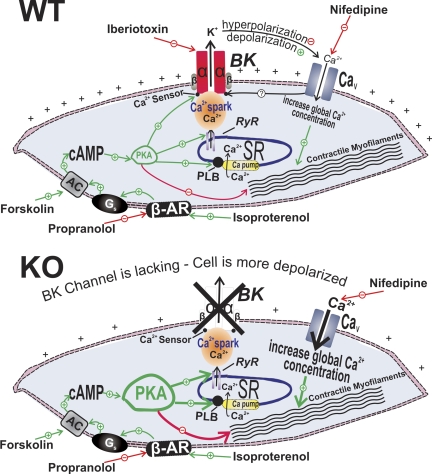Fig. 9.
Proposed mechanisms by which BK channels mediate β-adrenergic relaxation in UBSM cells with illustrations of the differential outcomes following channel pharmacological inhibition or genetic ablation in the WT (top) and the BK-KO mouse (bottom), respectively. In UBSM cells from WT mice, functionally active BK channels regulate Ca2+ entry via L-type voltage-gated Ca2+ (CaV) channels, and thus contractility (top). In addition, BK channels are under the local control of the so-called “Ca2+ sparks” caused by Ca2+ release from the ryanodine receptors of the sarcoplasmic reticulum, adjacent to the cell membrane (9, 20). After permanent BK channel gene deletion in the BK-KO mouse, an adaptive compensatory upregulation of the β-adrenergic receptor (β-AR)-cAMP-PKA signaling pathway develops. The enhanced β-AR/PKA activity compensates for the increased Ca2+ entry via L-type CaV channels that occurs due to sustained membrane depolarization in the absence on the BK channels. AC, adenylyl cyclase; Gs, stimulatory G protein; PKA, cAMP-dependent protein kinase; PLB, phospholamban; RyR, ryanodine receptor; SR, sarcoplasmic reticulum.

